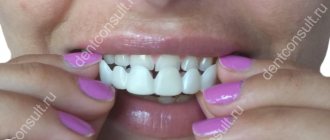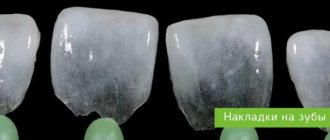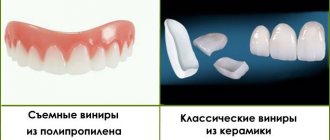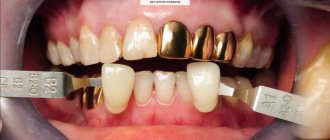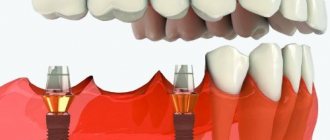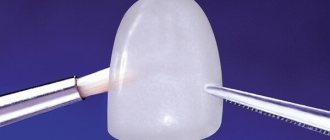December 27, 2017
Veneers are a remedy that will help make your teeth white and your smile radiant. In fact, they are microprostheses that look like thin plates. The linings are fixed to the front, visible part of the tooth; before this, in most cases, it is necessary to remove a thin layer of enamel from it for better fixation and to ensure that the teeth do not turn out to be too “thick”.
Veneers do not serve as a full-fledged prosthesis, covering only the outer part of the tooth, but they cope with decorative aesthetic functions perfectly, because that is what they were created for. Thus, onlays are used to make the dentition smooth and beautiful.
Veneers for teeth
The editors of the UltraSmile.ru looked into one of the most popular dental laboratories in Moscow and found out what materials are used today to create veneers and which ones are the best.
What kind of design is this and its features
What kind of dentures are these and how are removable dentures different from all the others? Removable veneers are veneers that can be removed. It would seem nothing complicated. But in this simplicity lies either an advertising ploy - it misleads patients, or such veneers will soon have to be replaced with permanent ones - which in theory they should be.
It is worth saying that not a single self-respecting orthopedic dentist will offer a patient removable “veneers” as an option to improve the aesthetics of a smile. What's the point here? In general, veneers1 are non-removable microprostheses - overlay plates on the upper and lower front teeth, which make them more beautiful in shape and shade. But such onlays are made in a dental laboratory (this is important!) within a few days or weeks. During this time, the patient is given temporary plates - composite or plastic, which will soon be removed. They are needed to protect the ground teeth from damage and temporarily give them a natural look.
Those removable veneers that are offered to patients on websites on the Internet or in advertising videos and booklets are most often similar to conventional silicone dentures for the entire jaw. They also resemble the joke “jaws” that people wear to masquerades, and even chewing gum in the shape of jaws. They attach very poorly to the mouth and, according to patients, they are completely impossible to wear. You can see how “natural and natural” such products look before and after installation - see the photo.
Benefits and harms
It is important to understand that the pros and cons of veneers directly affect the quality of your bite. Thus, without much effort, you can visually correct minor imperfections and ensure a whiter and brighter smile. And this is without grinding down the incisor, only with the removal of a thin layer of enamel. If all the rules are followed, the plate will need to be replaced only after 10-20 years - the positive effect is obvious.
On the other hand, abandoning them after the first fixation is already problematic. You have to wear them for the rest of your life, periodically lightening them or putting on new ones. Why? Because 0.5-0.7 of the natural protective coating has already been removed. And the same premolars under microprostheses may ache, because after dental treatment they will become more sensitive and will react more sharply to hot and cold food.
So you should carefully weigh the pros and cons before deciding to have your smile corrected.
Types of removable “veneers”
This group includes the following types of structures (although not all of them have the right to be called veneers):
- temporary onlays for teeth: patients wear them for about 2 weeks or more - up to 2 months. During this time, permanent onlays are made in the laboratory from ceramics, zirconium dioxide, and ceramic composite. Moreover, for both temporary and permanent overlays, the rule applies - each tooth has its own individual veneer, made from impressions,
- DenMat's Snap-On Smile Dentures: These are temporary dentures that look like veneers or crowns bonded together. They can be worn over the entire dentition or on a “problem” sector. Snap-On Smile not only improves the aesthetics of a smile, but can replace several missing teeth in a row. They are made individually from impressions sent to the manufacturer’s laboratory in the USA,
- removable “veneers” on teeth, “dental onlays” or “false teeth”, which can be purchased on the Internet, pharmacies or cosmetics stores: they look like a silicone prosthesis for the entire row, or single onlays that are glued at home yourself.
As for the last variety, there is no talk here of any individualized approach or taking casts. These “dentures” have a standard shape and are suitable for a person with perfectly straight teeth. But in any case, they will not stick well and will come off with a little pressure. So with such a “Hollywood smile” you can only smile (but even this is not a fact), but you won’t be able to chew food.
%akc72%
What are temporary veneers, why get them and how long will you have to wear them?
Today, installing veneers that make a smile attractive is a procedure that is available to everyone. And almost a century ago, only Hollywood actors could afford them, and even then not for long - only for the period of time while filming took place. Celebrity stylists put thin plates on the teeth as a kind of make-up or disguise defects, and glued them with a temporary composition. After 1-2 days, such overlays were removed. Today, high-quality veneers that are installed in dental offices are permanent structures that serve their owners for 5-7 or more years (depending on the properties of the selected material). However, on the Internet you can find information about removable veneers. What are these structures? Find out more in our article today!
What materials are they made from?
Overlay removable veneers are made of polymers, silicone, polypropylene, and plastic in light shades. These are inexpensive materials, they are easy to process and can be easily painted in enamel colors. But we must understand that even in professional dentistry such materials are used only on a temporary basis, because they have low performance characteristics. The materials are softer and more fragile than those used for real microprostheses. They also have irregularities and pores on the surface, into which dietary fiber and dyes become clogged.
Types of restorations with ceramic veneers
There are two types of porcelain veneers: pressed porcelain and porcelain-fabricated porcelain veneers. Initially, there are no special differences between the two types. The quality of structures is determined by further processing and installation.
Made from pressed ceramic
To create pressed porcelain veneers, wax modeling is first used. A model is created from special wax, according to which a ceramic plate is pressed under high pressure. On the front side of the plate, any anatomical features of the patient’s enamel are recreated. This method is good for accurately conveying the internal surface of the structure adjacent to the tooth.
Manufacturing on a refractor
When making a ceramic veneer using a refractor, special stumps are first created from a refractory mass, and then the ceramic mass is applied to them in layers. The finished structure is subsequently baked in a special oven.
Both types of ceramic veneers are offered. Regardless of the manufacturing method, ceramic onlays are always strictly individualized for the patient and installed at the highest level.
Advantages and disadvantages
The advantages or benefits, if you can call them that, are that for not very much money you can get a new look for some kind of masquerade or photo shoot. Then there are the disadvantages, which are mentioned by reviews from dentists and people who decide to buy removable dental veneers. The disadvantages of removable dental veneers are as follows:
- poor fixation in the oral cavity,
- the risk of getting into an awkward situation in society,
- not very aesthetic appearance,
- rapid coloring of lining materials with food coloring, tobacco smoke, etc.,
- discomfort when wearing: such pads are made according to a template, so they will be uncomfortable after installation. After all, absolutely every person has their own individual parameters for the shape and inclination of their teeth, their sizes - it is impossible to measure everyone with one “ruler”,
- unpleasant “chemical” smell or taste from materials,
- risk of complications: damaged enamel, pulpitis, injuries to teeth and gums, chemical and thermal burns, allergic reactions to materials, risk of choking on a peeling pad or swallowing remaining adhesive.
“I placed an order in one group and was led by praise and a large audience. And I was very pleased with the price - it was only 500 rubles, to be honest. But on the day I received it, it turns out I was added to the blacklist. And I couldn’t leave my not at all positive review. These turned out to be not veneers at all, but some kind of toys, just to scare children with them. They do not stick to the teeth and fall out constantly. In general, horror!!!"
Marina_99, review from the woman.ru forum
The benefits of veneers for teeth
Providing a beautiful smile and hiding minor defects, they have the following practical advantages:
- Durability - 5 years is their minimum service life, 7-10 is average (with careful biting of food, oral hygiene and compliance with other rules).
- Environmentally friendly, durable structures designed to minimize the risk of chipping.
- Hypoallergenic - in the manufacture of such pads, materials are used that not only do not cause irritation or other negative reactions, but are also biocompatible with all tissues of the body.
- Aesthetics – when considering the pros and cons of veneers for the front teeth, it is important to consider that they are completely invisible compared to other incisors; It’s not a problem to choose the shade, gloss and even the degree of transparency similar to natural enamel.
- Resistance to staining - the plates do not change their color after drinking tea, wine, coffee and other products, and do not turn yellow as a result of smoking or simply over time; If necessary, they can always be polished.
In addition, microprostheses are distinguished by gentle installation: before fixing them, there is no need to grind the incisor, it is enough to just remove a thin layer of enamel. Well, the edges of these overlays do not have to be hidden in the gums or other soft tissues of the oral cavity. This means no discomfort: with them, a person does not feel a foreign body at all and smiles as naturally as possible. There is also no need to get used to it.
How to use removable veneers
How to install and remove removable “veneers” will depend on their type. If the product is in the shape of a full jaw, then they are simply put on the teeth from above and removed from them by hand. Some sellers write that you first need to put the structure in hot water for a few minutes - almost boiling water - and then put it on. But in this case, there is a real risk of burning the gums and overheating the dentinal layer (it is located under the enamel), which can provoke pulpitis. Not to mention the discomfort of the installation process - some people report that it is painful or too hot for the teeth.
Removable “veneers”, which imitate real ones in their shape (but are sold in packs of 70 pieces, and are not made individually), are supposed to be fixed with a special adhesive using a brush and tweezers. And all this on your own at home. But if dentists use only professional formulations with proven components, then it is completely unknown what will end up in the package with “veneers”. It will be good if it is harmless glue (even if it comes off quickly). And if you come across a toxic substance that is difficult to remove, you will have to urgently seek medical help.
Cost and service life
Veneering, as an artistic restoration procedure, is always an individual work, painstaking and precise, requiring time and skill, designed for a number of sessions, which affects costs.
Also, prices directly depend on factors such as:
- material and type of records;
- fastening technology;
- number of nozzles;
- associated problems and pathologies.
The average service life is from 5 years (for composite) to 7-8 (for ceramic) or even up to 20 (for zirconium). True, these are not guaranteed figures: the time of comfortable wearing highly depends on attentiveness and accuracy. Some people manage to chip together microprostheses within a week, having decided to chew a pistachio or a “Grilyazh” candy, while others use them happily ever after, following all the rules prescribed by the dentist.
The range in cost allows you to make a choice. You can settle on budget options made from filling materials, get used to them, and then change to better ones. Well, or immediately spend money on a structure made of zirconium and ceramics for the long term. It's up to you to decide, but remember that each new installation means grinding down the enamel and paying for the dentist's labor.
What is better to choose?
If you understand the question of which removable “veneers” are better, then the only option would be Snap-On Smile dentures. They are made individually and from quality materials. But, since the plant is located in the USA, the patient will have to wait about 1-2 months, and the main waiting time will be spent on transportation. Again, you will have to first visit an orthopedist to take impressions and sanitize the oral cavity. As a result, the final cost of treatment can be close to installing real veneers.
South Korean implant Osstem - from 35,000 rubles.
Hurry up to sign up for a free consultation and lock in promotional prices.
Call now or request a call
Opening hours: 24 hours a day - seven days a week
Watch a video about installing veneers
Notice
: Undefined variable: post_id in
/home/c/ch75405/public_html/wp-content/themes/UltraSmile/single-item.php
on line
45 Notice
: Undefined variable: full in
/home/c/ch75405/public_html/wp-content /themes/UltraSmile/single-item.php
on line
46
Rate this article:
( 1 ratings, average: 5.00 out of 5)
veneers
How much does a “Hollywood” smile cost?
How much do removable dental veneers cost? If you study the offers on various sites, the average price will be 1,200 rubles for a complete “transformation” of your smile. But, as practice and reviews of people who have decided to make such a change in appearance show, this is money down the drain. In reality, such products will not make your smile more beautiful, and they are impossible to wear.
If the patient is interested in the cost of temporary veneers, which need to be worn while the permanent ones are being made, then their cost, as a rule, is already included in the overall price tag. Those. there will be no additional costs. Classic non-removable ceramic onlays for teeth cost from 15 thousand rubles and more - it all depends on the cost of materials and methods of processing them. By the way, if necessary, the doctor will be able to remove them and install new ones if the need arises.
1Gurel G. Ceramic veneers, 2007.
Your questions and answers
QUESTION I bought removable veneers online, but I cannot attach them to my teeth. They fall off constantly. Tell me how to do this better? Alexandra
ANSWER Hello, Alexandra. Unfortunately, there is nothing we can do here. Because these are not veneers at all, but their imitation. Real veneers are installed in dentistry using a special adhesive composition - and remain on it for years. Also, real veneers are made based on impressions of the patient’s dentition, i.e. they are individual and precisely adjusted to the parameters of a particular person. Whereas “veneers from the Internet” are template overlays made according to standards known only to the manufacturers themselves. That's why they don't stick to the teeth. The use of any independently selected adhesives is unacceptable, as this can only harm yourself. Therefore, we do not recommend wearing these products. But you can use them for creativity, crafts - whatever your imagination allows.
How to navigate the names
When choosing records, first of all look at:
- material – ceramics, zirconium, plastic, composite;
- thickness – the method of preparing a dental unit depends on it; the thinner the model, the less turning;
- manufacturer - give preference to a well-known brand whose products are reliable, safe, and time-tested.
In most cases, onlays are placed in the smile area - on the incisors, canines, and premolars. But they can also be fixed to molars. If the tooth is severely damaged, the standard option is not suitable. In this case, the product is installed 180° or 360°, covering the crown on all sides.
What is a classic veneer
This is the name for plates that are fixed only at the front. To attach them, the tooth is ground down, removing the enamel and part of the dentin (hard tissue). This is explained by the fact that:
- The structure of the enamel prevents high-quality adhesion, so it must be removed.
- Dentin needs to be prepared if the thickness of the plate is more than 0.5 mm. Otherwise, the bite will be disrupted, the shape of the face will change, and the patient will feel discomfort.
When you don’t want to sharpen your incisors, canines and molars too much, take lumineers. To fix them, only the enamel is removed.
Indications and contraindications
Despite the fact that veneers are a fairly universal design, they are recommended to be used only if indicated. The patient's desire alone is not enough for dental reconstruction.
Indications for the installation of veneers are considered to be pathological deviations of the tooth:
- damage, chipping or disruption of the natural structure (enamel);
- irregular shape;
- altered or natural “ugly” color;
- gaps or incorrect positioning;
- cracks;
- tetracycline
- hypoplasia or fluorosis;
- wedge-shaped defect;
Before the procedure, a diagnosis of the oral cavity must be performed to exclude contraindications, which include dental pathologies:
- washing fabrics;
- significant curvature;
- bruxism or stomatitis;
- periodontitis, caries or pulpitis;
- periodontitis, gingivitis or periodontal disease.
A specialist may refuse to install veneers if the patient has a severely altered bite or tooth position, has bad habits (addiction to smoking, alcohol or drugs), or has a large filling. It is also not recommended to place plates on people who do not sufficiently observe hygiene standards.
What will happen to veneers in 10 years?
If you have installed high-quality ceramic dental veneers, after 10 years you may not notice any changes at all. The overlays will remain as smooth and white as the day they were installed. Especially with proper care: thorough cleaning and use of professional pastes with a polishing effect.
The main dangers for veneers are mechanical damage and the accumulation of bacteria between the onlay and the tooth. In the latter case, an unsightly black border may appear along the edge of the tooth. If you take care of veneers, their service life can significantly exceed the 10 years “required” for ceramics.
In the case of componeers (composite overlays), after a couple of years you can expect darkening: the overlays become gray and look unnatural. This is how coloring products affect them: tea, coffee, chocolate, berries, beets. In rare cases, componers serve for 10–12 years, but completely lose their presentable appearance. As soon as this happens, you should immediately replace the veneers - the price will be the same as for installation.
Where is the best place to place veneers?
It's no secret that aesthetic operations such as the installation of veneers should be carried out only in serious and trusted clinics. From the best specialists. They are professionals in their field, with thousands of successfully performed veneering and aesthetic dental restoration operations behind them.
Why do we offer installation of veneers here, in our clinics?
All-Russian
The rating of private dental clinics in 2022 confirmed
the leadership
of the German Implantology clinics and the “Clinic over 3 years old”.
11,000 of the best
Russian dental clinics from more than 110 cities fought for the right to be the first, and we again became the best in Russia!
The award ceremony took place on September 23, 2022
within the framework of the largest dental exhibition in Russia -
DENTAL EXPO 2019
and
on September 22, 2022
at the
DENTAL EXPO 2020
.
In the category “Clinics up to 3 years of age” - the clinic of the Research Center in Ramenki:
In the category “Clinics over 3 years old” - the clinic of the Scientific Research Center on Kievskaya,
which has been successfully performing dental implantation for more than 9 years:

